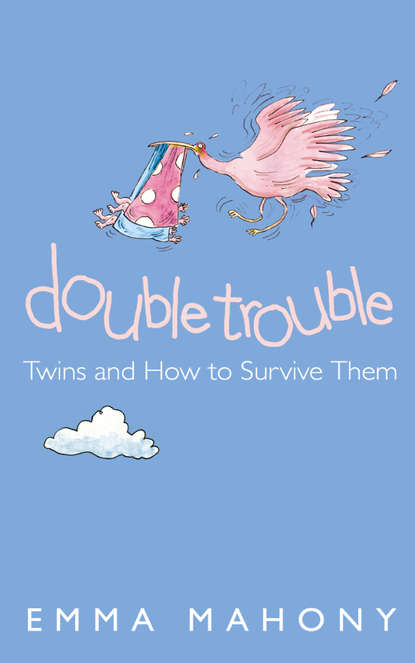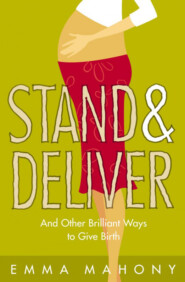По всем вопросам обращайтесь на: info@litportal.ru
(©) 2003-2024.
✖
Double Trouble: Twins and How to Survive Them
Автор
Год написания книги
2019
Настройки чтения
Размер шрифта
Высота строк
Поля
One good thing about identical twins is that when people ask you: ‘Are they identical?’ You can answer ‘Yes!’ (and so can your twins). However, be prepared for fresh idiocy. Caroline Watton, who has identical twin girls, was stopped by an old lady in the supermarket as she was pushing the girls around in a trolley. ‘Ooh, aren’t they sweet!’ cooed the old woman. ‘Are they identical?’ Before Caroline could answer ‘Yes’, the woman contradicted her. ‘Of course they’re not!’ she said. ‘Look, one’s fast asleep and the other’s awake.’ The nation’s biology teachers have a lot to answer for.
Just to confuse you further…
As well as the simple and straightforward combinations, there are small differences that will really make you confused. I don’t recommend you venture into conversation with any old women in the supermarket about the following subjects.
Mirror-image twins
About a third of all identical twins are ‘mirror-image twins’. If the one egg that splits does so later in the pregnancy, after the seventh day, then sometimes the twins have mirror-image traits – such as one is left-handed, the other right-handed. As they grow, you might notice one sprouting a tooth on one side, while the other does so on the other side, or different hair whorls curling in opposite ways. No-one is exactly sure what causes this effect, but it all adds to the mythology surrounding identical twins.
Identical twins who don’t look alike
Because some identicals share a placenta, and don’t always have equal access to the nutrition because of how they are lying in the womb, they may have quite different birth weights. The weight soon equalizes after birth, however, but the changes in the shape of the face or bodily difference may stay for life. Identicals may also have slightly different hair colour and birthmarks.
Twins that result from superfecundation
Superfecundation describes the fertilization of two eggs after two or more bouts of sex during the same menstrual cycle. Given the small window of ovulation and the short lifetime of a sperm, these bouts of sex have to take place quite close together. Very interesting. Could this be you? (unlikely if you have any other children in the house).
Superfecundation gives rise to the possibility of twins with two different fathers, for women who might wave their husbands off to work and then open the back door to the milkman. Rare incidents of mixed-race twins where one baby is born black and the other white can also happen in normal twin conception with the same father, as in the case of the twins Karen and Cheryl Grant from Essex, now 19.
IVF or natural? Who cares?
I’ve included the question of whether your twins are ‘IVF’ or ‘natural’ because you’d be amazed at how many people think it is their business. You have probably already been asked this, usually by Ms Nosey Parker.
My view, whether you conceived with the help of IVF or not, is to tell people a lie. Anyone tactless enough to ask deserves to be led astray. As long as those who conceived naturally are quick to answer ‘naturally’, as if there is something inherently better about this answer, then people will continue to ask. Perhaps you could ask a question back to Ms Parker, such as ‘What is IVF exactly?’ and then nod interestedly as she attempts to explain. Then ask her, regardless of whether she’s had children or not, whether she’s had IVF herself, because she seems such an authority on the subject.
Men and the assisted conception business
When my husband told a West Indian client that his wife was expecting twins, the client slapped him on the back and shouted, ‘Congratulations! Mon, you shoot with double barrel, never miss – Bam! Bam!’ The Jamaican summed up the view that all men secretly share – that twins are an expression of a man’s (not a woman’s) fertility. I haven’t met a single father of twins who hasn’t puffed up his chest when remembering his own important walk-on part in the twin drama.
Of course, all women know that this Woody Allen view of sperm is ridiculous, and that all sorts of complicated factors are involved to make conception possible. However, there is no harm in encouraging this virile fantasy (and if that means suppressing the information that they are IVF, just carry on lying) because a swaggering partner in the early days is more likely to be a helpful one later on. All women know this instinctively, so you don’t really need to be told.
The IVF twin mix-up stories
The ‘mix-up-in-the-lab’ story is recycled again and again whenever the latest fertility scare happens. This is a variation on every woman’s irrational fear that her baby will be switched by mistake when the nurses are chatting abstractedly over a cup of tea. This fear is as old as the hills. My mother admits to being so scared by it that she insisted on having a home birth for her first born, back in 1961. When my 11lb (ouch!) big brother finally appeared, I think few would have mixed him up with some 5lb weakling.
There are three twin mix-up tales in the IVF history books. The first was when a white mother gave birth to black twins in the summer of 2002 here in Britain. The sperm was wrongly mixed with the woman’s eggs after a laboratory error in an NHS clinic, and the legal outcome determining who are the parents has yet to be settled.
The other two happened elsewhere in the world. The first was in 1993 in Holland where twin boys, one white and one black, were born to Willem and Wilma Stuart after two samples of sperm became accidentally mixed before being used to fertilize Wilma’s eggs. The biological father made no attempts to gain custody of his twin, but the family keeps in touch in the event that his biological son may want to meet him one day.
The second case happened in 1998 in New York when two lots of embryos were mixed and both women, Donna Fasano and Deborah Rogers, were implanted with what they took to be their own embryos. Only one of the pregnancies turned out to be successful, and the mother had one black and one white twin. There followed a difficult legal battle, leading to the black twin being handed over to his biological mother. Despite the recrimination between the parents and the hospital, the now four-year-old twins still visit each other.
Natural or not so natural?
The folic acid factor
New research
(#litres_trial_promo) also suggests that women who take folic acid are nearly twice as likely to give birth to twins as women who do not. A higher rate of twin births in relation to folic acid was first noticed in an earlier Hungarian trial. The recent Swedish research team examined Swedish records since 1994. The scientists found that among 2,569 women who had used folic acid supplements, the rate of twin births was 2.8 per cent – nearly double the normal level of 1.5 per cent. They are unsure why folic acid might be responsible for producing more twins. It is possible that folic acid encourages multiple ovulations or the implantation of more than one egg. It might also prevent the spontaneous abortion of one or more foetuses occurring in women who do not take folic acid.
The official advice is still for women to take 400mcg of supplemented folic acid before conception and for the first three months of pregnancy (see also www.hsis.org – Health Supplements Information Service).
I took 12 times the recommended dosage because my first baby was born with a cleft lip and palate, so I read the study with interest. But, then again, I also fell into all of the other categories that made me more likely to have twins: I was over 35, taller and heavier (charming) than your average British mother, a twin myself who had already had one child.
TWIN PREGNANCY VITAL STATISTICS
(#litres_trial_promo)
Natural conception:
The chance of having twins rises steadily as the mother gets older.
The peak age is 35 to 39 for European women.
Women are more likely to have twins the more children they have, independent of their age.
Fraternal or non-identical twins are more common if there is a presence of twins on the mother’s side of the family (contrary to popular opinion, the father’s side makes no difference).
Identical twins are random and occur in one in three of all twin births (although scientists are still trying to explain why they occur more in some families).
You can insure against the extra cost of having twins before your 14th week of pregnancy, providing you are not having IVF treatment and have yet to be scanned by your doctor. At the time of going to print, insurance company Marcus Hearn (0207 739 3444) will pay out £1,000 for a minimum premium of £42.
Assisted conception:
Since the very first test-tube baby Louise Brown was born in Britain in 1978, in vitro fertilization now accounts for around 8,000 babies born every year in Britain.
One in four IVF pregnancies results in twins.
The number of triplet births has risen from 91 in 1980 to 262 in 2002.
The number of twin births has grown from 6,400 in 1980 to 8,500 in 2002.
In Britain alone, the number of cycles of treatment has risen from 28,000 in 1991 to 44,000 in 2002.
A quarter of infertile couples succeed with IVF.
THREE Eating and Exercising for Three (#ulink_b872dd81-6189-531d-8be0-ea68015a4016)
Make no mistake: one good thing about a twin pregnancy is that you get to eat a lot, and most of the weight will go on the babies. All of us who have had guilt issues surrounding food can now look forward to nine months of bingeing, and even longer if you hope to breastfeed. For a twin pregnancy, you are not only invited to eat one-and-a-half times more than for a singleton pregnancy, it is practically a responsibility.
(#litres_trial_promo)
There is also enough evidence now to support the welcome news that in a twin pregnancy there is a direct correlation between higher maternal weight gain and better birth outcomes.
(#litres_trial_promo) So, what are you waiting for? Order that Fortnum & Mason hamper now. This should be the rekindling of a long love affair with food.
During my own twin pregnancy, which was remarkably trouble-free and ran the whole course to term at 40 weeks, I went food mad. I decided to allow myself absolutely no restrictions on the amount of food I ate, and arrived at work having visited the deli with two plastic bags from the greengrocer and the baker en route. For all my no-holds-barred approach, I was very picky about the type and quality of food I ate. In my first pregnancy, I had put on a lot of weight by eating badly, pretending that my penchant for crisps, cider and Maltesers was a craving. It took me 18 months to shift the excess stone (or two).
Second time around, I had learnt my lesson about office vending machines and was careful about the type of food I ate. I would bring in as much fruit and raw veg as I could carry – carrots, cucumber, tomatoes, cauliflower, apples, bananas and grapes. Added to this would be a mixture of cheese, quiches and whatever else shouted ‘eat me!’ from the deli that day. Should anyone ever question you on the size of that cheese sandwich you are about to put in your mouth, just remind them that you are ‘eating for three’.






